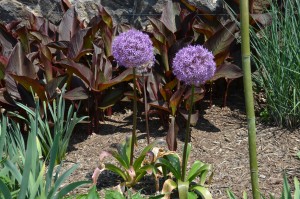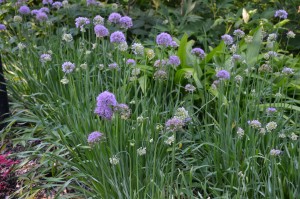Ornamental alliums, members of the onion family (Amaryllidaceae), produce flowers that are uniquely ball shaped and stand atop long, graceful stems. Young children marvel about the lollipop or stargazing blooms. Depending on species, alliums come in many colors (white, yellow, pink, purple, blue), shapes (round, oval, cascading), and sizes (5 inches to 5 feet tall).
Most alliums bloom from late spring to early summer. They bridge the gap between spring bulbs and summer flowering perennials. Most grow well in containers, either planted alone or mixed with other plants. Blooms attract bees and butterflies and are terrific as cut flowers.
According to size, the short alliums include: A. flavum, A. karataviense, A. sikkimense, and A. schubertii. They fit well in rock gardens or along garden paths. For a mixed perennial border, choose intermediate 2-3 feet tall cultivars with 4-6 inch diameter spherical blooms: ‘Purple Sensation’, ‘Gladiator’, and ‘Mount Everest’.
Giant flowering types with stunning 8-10 inch diameter stargazing globes include: Stars of Persia and ‘Globemaster’. A little different are the shorter growing, egg-shaped flowering types of German chives (A. lusitanicum), drumstick alliums (A. sphaerocephalon) and fragrant Chinese chives (A. tuberosum).
Ornamental alliums are very easy to grow. Just plant them in the fall at the same time that you set tulips, daffodils and other spring flowering gems. Most alliums thrive in zones 4-8 and bloom year after year. Flowers are long-lasting both in the garden and in bouquets. When flower heads lose their color, the seed heads continue looking good for a month or more. Remove flower heads before seeds drop to avoid creating a weedy mess.
Alliums are critter-proof. Deer, voles, chipmunks and squirrels do not eat them. Harmful insects don’t bother them, and flowers are frequented by bees and butterflies for their nectar. Alliums are also disease free.



 Posted in
Posted in 
